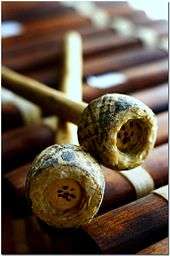Garifuna music
Garifuna music is a type of music found in Central America, primarily on the Caribbean coast of Belize, Guatemala, Honduras, and Nicaragua.
The Garifuna (/ɡəˈrɪfʉnə/ gə-RIF-uu-nə; pl. Garinagu in Garifuna) are descendants of West African, Central African, Island Carib, and Arawak people.
Garifuna music and dance are closely related. The main traditional instruments are drums and maracas.[1]
Drums play an important role in Garifuna music. The main drum is the Segunda (bass drum). The drums are normally made by hollowing out logs and stretching antelope skin over them.[1]
There are certain types of songs that are associated with work, some with play, some with dance and some that are reserved for prayer or ritual use.[1]
Two main Garifuna genres are punta and paranda.[2]
Chumba and hunguhungu are a circular dance in a three-beat rhythm, which is often combined with punta. There are other songs typical to each gender, women having eremwu eu and abaimajani, rhythmic a cappella songs, and laremuna wadaguman, men's work songs.
In 2001, Garifuna music, dance, and language was proclaimed as a Masterpiece of the Oral and Intangible Heritage of Humanity by UNESCO.[3]
References
- 1 2 3 "Garifuna Music and Dance". National Garifuna Council of Belize. Retrieved 8 February 2015.
- ↑ Michael Stone. "400 years of fury, 400 years of sound". Roots World. Retrieved 2 November 2014.
- ↑ "Language, Dance and Music of the Garifuna". UNESCO Culture Sector. Retrieved 2009-09-07.
